1. INTRODUCTION
Bamboo resources in Indonesia is abundant and have a big potential for new products developement. Bamboo plantation in Indonesia in 2000 was 2,104,000 ha, consisted of 690,000 ha in permanent forest and 1,414,000 ha in non-forest areas (FAO and INBAR, 2005). Widjaya (2012) reported that there were 160 bamboo species consisted of 122 endemic species and 38 exotic species. Compared to wood, bamboo has fast growth rate, abundant potency, short cycle, and adaptable to most of soil types except soil in the beach area. In addition, the tensile strength of bamboo is comparable to wood. Due to its advantages, bamboo has been used as raw materials for industry, construction, furniture, household equipment, and handicrafts. However, bamboo also has some limitations when they are used for construction material, particularly due to its diameter. The small diameter and thin culm of bamboo made the solid bamboo difficult to be used for panel products that generally needed a long and wide dimensions. In addition, bamboo also has low modulus of rupture and high variability of physical properties, particularly the density in the bottom, middle, and upper parts.
Composite products can be used as alternatives to increase the efficient utilization of bamboo for structural and non-structural applications. Oriented strand board (OSB) is one of the structural composite panels that has been used as a substitution for plywood products. Structural Board Association (2005) defined OSB as structural composite panel made from long and thin strand with the core layer alligned perpendicularly to the back and surface layers and compacted using hot pressing. Our previous studies revealed that the physical and mechanical properties of bamboo OSB (B-OSB) were higher than those of OSB from wood, and met the standard requirement for commercial OSB (Febrianto and Hadi, 2010; Febrianto and Arinana, 2012; Febrianto et al., 2012; Adrin et al., 2013; Febrianto et al., 2013; Febrianto et al., 2014).
The properties of particleboard and OSB are affected by wood species, density, strand dimensions, strand pre-treatment, particle orientation, resin type and content, layer orientation, pressing parameters, moisture content and board density, and density profile of the board (Maloney, 1993). The extractive content of bamboo, particularly the carbohydrates and sugars content is relatively higher than wood (Fatriasari and Hermiati, 2008; Zhang, 1995). Carbohydrates and sugars are food sources for wood-damaging agents such as wood-decaying fungi, moulds, wood-destroying insects or marine borers which make bamboo susceptible to be attacked by such damaging agents (Febrianto et al., 2013). Pretreatment on strands can be applied to solve the problem, such as steam treatment.
Conventionally, steam treatment is generally applied for solid bamboo during the production of bending products to soften its tissues, hence bamboo becomes easier to be bended into desired form. Steam treatment could improve the durability of bamboo againts degrading agents (Liese, 1987). During steam process, free sugars in lignocellulosic materials is converted into intermediate furane and furane resin to improve the board properties (Rowell et al., 2002). Steam treatment of strands has been reported to improve the properties of OSB from sentang (Melia excelsa) wood (Iswanto et al., 2010). In our previous study, we reported the properties of B-OSB from steam-treated bamboostrand binded with isocyanate resin (Febrianto et al.,2015). However, the effects of strand steam treatment on the properties of B-OSB binded with formaldehyde-based resin has not been reported. Therefore, the objective of this study is to evaluate the properties of B-OSB with and without steam treatment, using PF resins as adhesives.
2. MATERIALS and METHODS
Two bamboo species, i.e. andong (Gigantochloa psedoarundinacea) and Betung (Dendrocalamus asper) were obtained from 3-year-old bamboo plantation in Sukabumi, West Java, Indonesia. PF resin was used as a binder. Chemical reagents were used for the determination of differeent extractive contens. Main equipments used in this study are band saw, circular saw, planer, disk flaker, kiln drying furnace, shieve, water bath, oven drier, digital weight scale, moisture meter, glue blending drum, spray gun, strand orienter, forming device, caliper, hot press, and universal testing machine (UTM) instron.
Bamboo culms without internodes were converted into strands using disk flaker. The strands were treated with steam at 126°C for 1 h under a pressure of 0.14 MPpa. Strands were air dried for a week then oven dried at 60-80°C for 3 days until reaching moisture content of less than 5%. Three-layer B-OSBs were made with the dimension of 30 × 30 × 0.9 cm3 (length × width × thickness) using a face-to-core layer ratio of 1 : 1 : 1 (→ change this to a face to core rartio such as 60 : 40, 55 : 45). The target board density was 0.7 g/cm3. PF resin was used as a binder with the solid content of 42% and resin content of 8%. An addition of 1% wax was used. The strands were then hot pressed at 135°C under a pressure of 25 kgf/cm2. The resulted B-OSBs were conditioned for two weeks under room temperature (25-30°C) until reaching a constant weight.
Strand geometry was measured using 100 strands that obtained randomly. Dimensions of strands such as length, width, and thickness were measured. The slenderness ratio (SR) and aspect ratio (AR) of the strands were determined according to the method described by Maloney (1993).
The extractive content of bamboo strands before and after steam treatment was analyzed in accordance with TAPPI standards. Samples were extracted using alcohol-benzene solvent following the procedure of TAPPI T 204 om-88 (TAPPI 1991).
The physical and mechanical properties of B-OSB were evaluated according to the procedure of JIS A 5908-2003 (JIS 2003) for particleboards. The physical properties evaluated were density, moisture content (MC), water absorption (WA), and thickness swelling (TS), while mechanical properties evaluated were modulus of rupture (MOR), modulus of elasticity (MOE), and internal bond (IB) strength.
3. RESULTS and DISCUSSION
Strand geometry is a prime parameter affecting both board properties and its manufacturing process. Suchsland and Woodson (1990) suggested that strand geometry is of greater significance in the development of board properties than the actual mechanical properties of the strands themselves. It has a definite relationship with the compression ratio, and thus it will influence the density of composite board. The strands manufactured have satisfactory geometry, showing high values of slenderness ratio (SR) and aspect rato (AR) as shown in Fig. 1. The average SR of strands from andong and betung were higher than 100 and classified as high SR (Febrianto et al., 2015). Strands with high values of SR affected on a better contact between strands and improved strength properties of the boards (Maloney, 1993). The average AR of strands from andong and betung were greater than 3. Maloney (1993) stated that wood strand having aspect ratio greater than one are easily oriented during forming process. According to Shuler et al. (1976) and Kuklewski et al. (1985), strand aspect ratio of two is enough to produce OSB with superior properties.
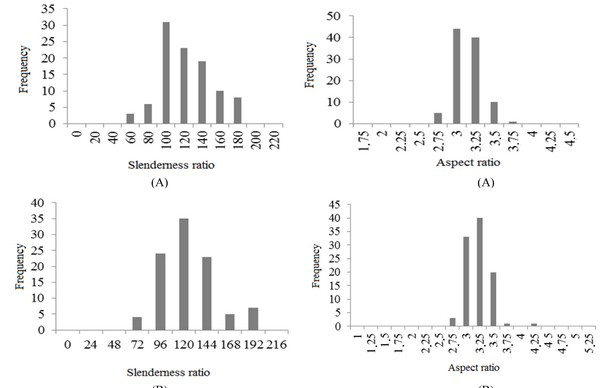
The results of extractive analysis showed that the extractive content of andong and betung decreased by steam treatment (Table 1). Steam treatment caused the loosening and softening of cell walls, resulted in the reduction of extractive content. Donohoe (2008) stated that during steam process, the heat and pressure applied increased the porosity of cell walls (Donohoe, 2008). Miranda et al. (1978) added that steam could cause depolymeration and repolymeration of lignin. This caused the extraction of extractive decreased in the bamboo strands.
The density of particleboard is affected by the density of the raw materials, which makes a contribution to the physical and mechanical propeties of the board (Tsoumis, 1991). The densities of the manufactured B-OSBs were ranging between 0.70-0.73 g/cm3 and 0.71-0.72 g/cm3 for andong and betung, respectively. The results of analysis of variance (ANOVA) at a significance level of 0.05 showed no significant density difference between bamboo species and strand treatment.
The moisture content (MC) values of B-OSBs from andong were ranging between 9.38% and 10.38%, while betung between 9.38% and 10.33%. B-OSBs of both bamboo species were relatively homogeneous, showing no significant differences in the MC values between species and strand treatment.
Water absorption (WA) and thickness swelling (TS) are of the important parameters to evaluate the dimensional stability of composite panels. WA shows the ability of board to absorp water due to adsoption force, which is the captive force of water molecules in the hydrogen bonds located in cellulose, hemicellulose and lignin. WA values after 24 h of water immersion were ranging between 45.35-46.82% and 38.18-43.56% for B-OSBs from andong and betung, respectively (Fig. 2a). The results of ANOVA revealed that bamboo species and strand treatment contributed significant effects on the WA property, while the interaction between species and strand treatment showed no significant effect. TS values after 24 h of water immersion were ranging between 8.77-9.82% and 5.91-7.50% for B-OSBs from andong and betung, respectively (Fig. 2b). The results of ANOVA revealed that bamboo species and strand treatment contributed significant effects on TS values, while the interaction between species and strand treatment showed no significant effect.
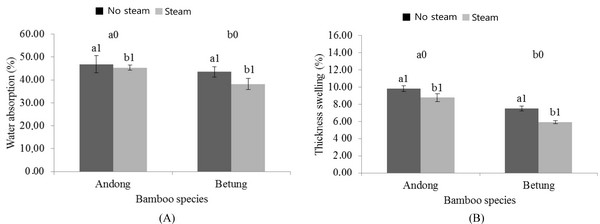
Steam treatment of strands reduced the WA and TS of the B-OSBs from andong and betung. It was believed that the removal of extractives in bamboo due to steam treatment improved the penetration of resin into the strand. The improved bondability of strands resulted in a decrease in the WA of B-OSBs. B-OSBs from betung had lower WA and TS values compared to those of andong due to distinctive anatomical structures between these two species. Andong has vascular bundle type III, while betung has vascular bundle type IV with a relatively higher content of holocellulose and lignin (Liese, 1998). Lignin in the structure of wood and other lignocellulosic materials acts as a thermoplastic binder that can enhance the bond between fibers, and improves the dimensional stability of composite panels. In addition, the extractive contents in andong and betung might also be ascribed to the hygroscopic behaviour of the B-OSBs.
MOE shows the ability of a material to maintain its original form during loading. MOE values parallel to the grain direction of B-OSBs were ranging between 70131-100965 kg/cm2 and 81831-115610 kg/cm2 for andong and betung, respectively (Fig. 3a). By contrast, the MOE values perpendicular to the grain direction of B-OSBs were ranging between 11407-13097 kg/cm2 and 10662-11625 kg/cm2 for andong and betung, respectively (Fig. 3b). The results of ANOVA showed that bamboo species and strand treatment had significant effects to MOE values in both parallel and perpendicular direction, while the interaction between species and strand treatment was insignificant.
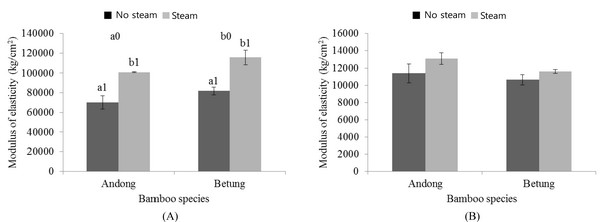
MOR shows the maximum load that can withstand by a materials. MOR values parallel to the grain of B-OSBs were ranging between 394-696 kg/cm2 and 524-763 kg/cm2 for andong and betung, respectively (Fig. 4a). The results from ANOVA showed that bamboo species and strand treatment contributed significant effects on MOR values parallel to the grain direction. MOR values perpendicular to the grain of B-OSBs were ranging between 119-211 kg/cm2 and 157-242 kg/cm2 (Fig. 4b). The ANOVA results showed that the interaction between species and strand treatment had significant effects on MOR values perpendicular to the grain direction. The results revealed that bamboo species and strand treatment affected the bending strength of B-OSBs including MOE and MOR. Steam treatment decreased the extractive content of andong and betung (Table 1), resulting in a better strand adhession. Maloney (1993) explained that extractives could interrupt the penetration of adhessive into materials, causing a decrease of mechanical properties.
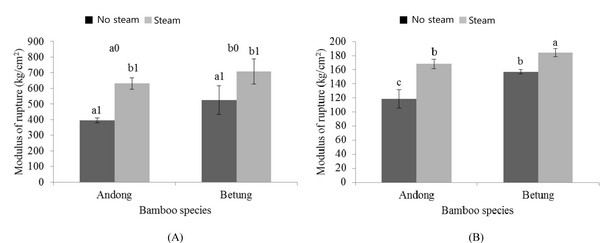
Steam treatment of strands improved the bending strength parallel and perpendicular to the grain of B-OSBs from andong and betung. B-OSBs from betung strands showed better bending strength compared to andong due to the differences in anatomical structure and the initial density of the bamboos. As described earlier in this paper, andong has vascular bundle type III, while betung has vascular bundle type IV. Latif et al. (1990) and Nuryatin (2012) reported that vascular bundle attributed to the values of MOE and MOR. The initial density of andong and betung were 0.72 g/cm3 and 0.66 g/cm3, respectively. With the target B-OSB density of 0.7 g/cm3, the compression ratio of B-OSB from betung was significantly higher than that of B-OSB from andong, resulting in a better bending strength values. The results were in a good agreement with those of Sumardi et al. (2006) that evaluated the relationship between compression ratio and bending strength of OSB from moso (Phyllostachys pubescens) bamboo.
IB strength, or the tensile strength perpendicular to the plane of the panel is one of the important strength properties of composite panels. The IB strength values were ranging between 4.01-5.62 kg/cm2 and 3.89-4.73 kg/cm2 for B-OSBs from andong and betung, respectively (Fig. 5). The results of ANOVA showed that bamboo species and strand treatment had significant effects on the IB strength values of B-OSBs. Steam treatment of the strands improved the IB values of B-OSBs from andong and betung. Steam treatment could convert free sugars in woody materials into furan intermediates, which can be further converted into furan resins, causing an improvement of mechanical properties and the dimensional stabilization of boards (Rowell et al., 2002).
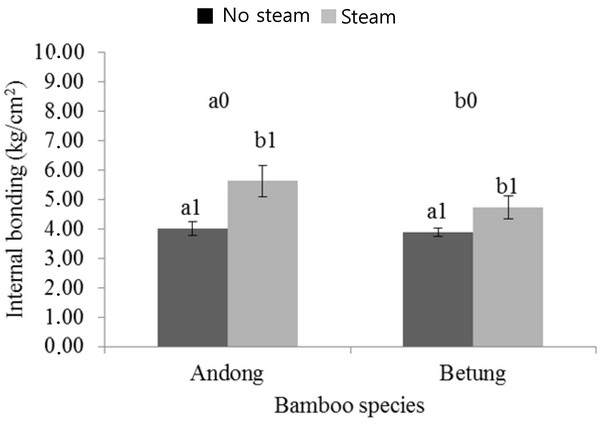
According to Maloney (1993), the extractive in woody materials can cause a problem during particleboard production due to its negative effect on the penetration of adhessive into particles. Steam treatment effectively reduced the extractive content of andong and betung, resulting in a better penetration of adhesive into strands and an improvement of strength properties of B-OSBs. The increase of IB values of B-OSB from andong with steam was relatively higher than that of B-OSB from betung. This might be due to more extractive dissolved from andong compared to betung. Table 1 shows that NaOH-soluble extractive of andong decreased more significantly compared to betung.
4. CONCLUSION
The geometry of strands produced from andong and betung bamboo were satisfactory, showing high slenderness and aspect ratio. Steam treatment of strands significantly reduced the extractive content, and thus improved the dimensional stability and mechanical properties of B-OSBs from andong and betung strands with superior properties of B-OSBs after the treatment than those of B-OSBs without the treatment. A simple and relatively low-cost steam treatment of strands offers a promising alternative treatment to produce B-OSB with high dimensional stability and mechanical properties.








